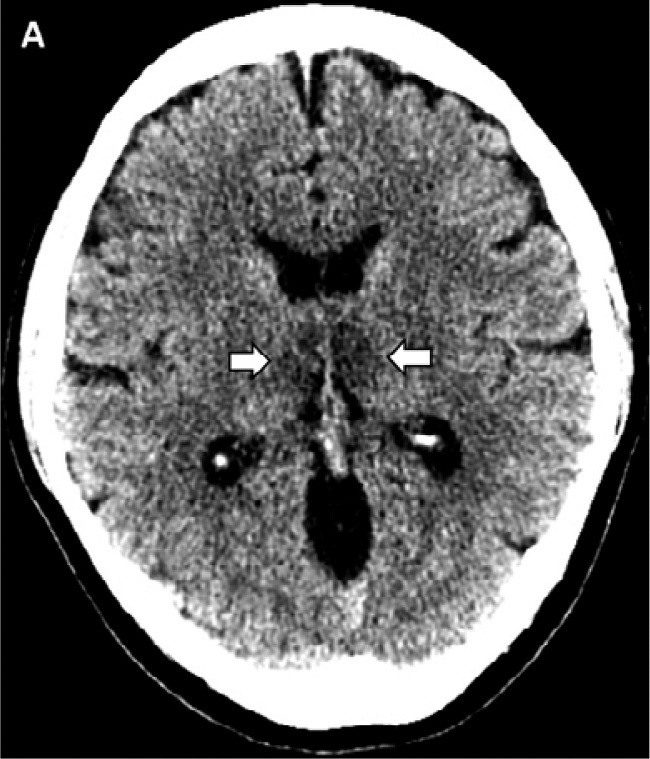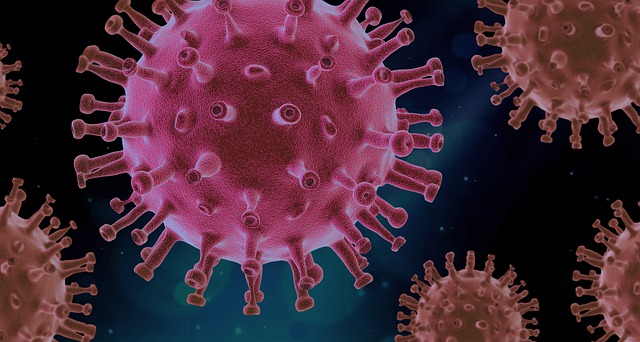A recent article, posted online, described a woman in her 50s who had traditional symptoms of COVID-19 at first but then developed an altered mental state. She was studied by MRI that reportedly showed capillary hemorrhage (no stroke) involving a part of the brain known as the thalamus. Another article reported the radiological study of 56 patients with the thiamine deficiency brain disease known as Wernicke encephalopathy (WE). MR imaging findings reported that “80 % of the patients had evidence of symmetrical lesions in the medial thalami”, part of the brain which might justifiably be referred to as the part that computes a defensive, adaptive response.
Experimental thiamine deficiency in animals is a classical model for the study of metabolic encephalopathy and selective cell loss of the brain resulting from a generalized low-grade oxidative deficit. Late stages are characterized by hemorrhage in the brain and on day 13 of the experiment, tissue damage and hemorrhage was found in the thalamus. In a study of experimentally induced thiamine deficiency in mice, petechial hemorrhage was found in the brain tissues. Of course, it is not possible to tie these references together to indicate that the encephalopathy resulting from COVID-19 is due to thiamine deficiency. However, taken as a whole, they support the idea that the mental symptoms might well be a reflection of a brain energy deficit arising from a failed initiation of an automatic, defective defense program.
The question then arises: is there evidence for thiamine deficiency in other virus diseases? Wernicke encephalopathy has been described in AIDS patients, a disease that has been associated with viral cause. However, the lifestyle and diet of such patients is often questionable and may confuse the issue. Chronic hepatitis B, a viral disease, is an international health concern that results in liver failure and death. Indirect evidence suggested a relationship between thiamine treatment and aminotransferase levels (a laboratory test that indicates faulty energy metabolism), a report begging for clinical trial with megadose thiamine. Patients with sepsis are frequently thiamine deficient. This deficiency can cause congestive heart failure, peripheral neuropathy, Wernicke encephalopathy and gastrointestinal beriberi concomitantly, because it results in energy deficit. This should alert emergency room physicians to such a possibility with COVID-19, particularly with the more severe symptoms.
The point that I am trying to make here is that our conventional approach to disease may be catastrophically wrong. The symptoms, particularly those that are obviously related to brain function, arising from COVID 19 may be just expressions of a defensive war where failure spells death and recovery spells victory. The potential involvement with thiamine metabolism strongly suggests energy deficit as the underlying mechanism and that treatment should be aimed at “supporting the defense” by providing its stimulation instead of trying to find a means of killing the virus.
Drug Related Thiamine Deficiency
Drug-nutrient interactions have the potential to cause serious adverse events but unfortunately they receive little attention during drug development. Their importance was highlighted when the clinical trial of a drug had to be terminated because it was found that it interfered with thiamine absorption. The authors screened 1360 compounds, including many clinically used drugs and identified 146 that had this inhibitory reaction. The antibiotic metronidazole (Flagyl) is converted to a thiamine analog (a nearly identical formula), with consequent vitamin B1 antagonism, thus explaining how “toxicity” is produced by this drug. Serum thiamine levels were significantly lower in a group of patients with neurological symptoms receiving chemotherapy for gastrointestinal cancer. Perhaps the use of pharmacotherapy is another example of a fundamentally inappropriate treatment of symptoms without addressing the real issue.
We are beginning to understand that the organizational capacity of the brain in setting up a defense against a lethal microorganism requires an enormous amount of energy. Perhaps it is the present preoccupation with finding a name for a disease, based on its locality in the body that diverts our attention. A good example was published some years ago in Japan. Since the early 1960s a peculiar neurological disease became prevalent throughout Japan. It went by the name of subacute myelo-optico-neuropathy (SMON), later to be found due to the prescription of a drug called clioquinol for diarrhea. Apparently the cause of the disease had been ascribed to a virus as early as 1978. It should be apparent that discussing differences in the cause of disease would not matter nearly as much if a nutraceutical approach to treatment were to be adopted. The concept is reinforced by the information on television that 70% of COVID deaths occur in the black community where poverty and malnurition tend to go hand in hand. It would explain the reason why some people have only mild symptoms while others succumb, why concomitant disease and aging are risk factors. Could it be that all disease is just a temporary lack of ATP (sometimes referred to as the energy currency) arising from nutritional error, coupled with genetic risk: that nutraceuticals are the ubiquitous treatment for all?
We Need Your Help
More people than ever are reading Hormones Matter, a testament to the need for independent voices in health and medicine. We are not funded and accept limited advertising. Unlike many health sites, we don’t force you to purchase a subscription. We believe health information should be open to all. If you read Hormones Matter, like it, please help support it. Contribute now.
Yes, I would like to support Hormones Matter.
Image credit: COVID-19–associated Acute Hemorrhagic Necrotizing Encephalopathy: CT and MRI Features















You are quite right. Thiamine is an oxidant and an antioxidant and vitamin C is primarily an antioxidant although it can also act as an oxidant. The whole point is that the genius of Mother Nature is “burning” (oxidizing) calories by the use of oxygen, but as an intermediate, not too much and not too little. An unbalanced or deficient supply of ATP results in energy deficiency, particularly in brain. The compensatory backup is the mobilization of creatine phosphate to make ATP anaerobically. That results in symptoms that notifies an energy crisis. The commonest cause of energy deficiency is thiamine deficiency. The lab study of the urinary creatine/creatinine is the first sign of aerobic energy deficiency.
Dr. Lonsdale,
I was reading what you wrote about a possible thiamine/ COVID-19 connection and wanted to share something that I think might be related.
Many years ago, I read a book called “Every Second Child” by Dr. Archibald Kalokerinos. It is about his experience with Aboriginal children in New South Wales. The Aborigines were often malnourished, sickly, and full of parasites. There were serious problems with diabetes and alcoholism. And the Aboriginal infants had an unusually high death rate; it was thought to be SIDS. Vaccine deaths were also a terrible problem. In one area, during a vaccination campaign, nearly 50% of the vaccinated children died—hence the book’s name, “Every Second Child”.
After many years, Kalokerinos eventually concluded that the affected infants were suffering from acute scurvy. He cured the children with injections of vitamin C. After he began the vitamin C injections, the infant death rate in his town dropped to zero.
The cause of the scurvy is what interested me, and I wonder if it might relate to health issues with Covid-19. Kalokerinos speculated that the cause of the acute scurvy was an endotoxin in their guts. The children already had nearly non-existent vitamin C levels for a variety of reasons Kalokerinos describes, and when the endotoxin escaped into their systems, it caused the acute scurvy. The endotoxin would attack the respiratory center of the brain, causing hypoxia and sudden death.
For the same reason, the children who received the vaccines died. They were already depleted of vitamin C, and when the vaccine was administered it caused a crisis–acute scurvy, and then death.
The symptom profile he describes with the endotoxin is, I think, strikingly similar to that of COVID-19.
Here is a transcript of a portion of an interview done with Dr. Kalokerinos in 2004. He had been curing the Aboriginal children with vitamin C for some time, but wasn’t quite sure why it worked. He says this is the moment he figured out how all the pieces of the puzzle fit together. https://www.youtube.com/watch?v=8heF0agXrxU
“(My friend) had developed a hypothesis, this theory, that these toxins (in the gut) were responsible for the sudden infant death syndrome. Now, suddenly, when he told me that, I understood for the first time why the injections of vitamin C were so dramatic in their effects. The causes of the pathology with the children; the sudden shock, the sudden unconsciousness, the sudden death, the basic cause was endotoxin produced in the body mainly in the gut, from organisms in the gut. And when it gets loose, all hell gets loose with it. And one of a series of different things can happen. The endotoxin, if the liver can’t handle it, if it’s absorbed from the gut, gets loose in the bloodstream. It’s taken to the brain, where it has very specific effects. And one effect is to destroy the respiratory center in the brain. So they stop breathing. At the same time, it affects the way the blood coagulates. So if you look carefully and study the pathologies in the sudden infant death cases you will find coagulation disorders of a marked degree. You will find little hemorrhages here and there. The whole thing fits together perfectly. So when I gave the injections of vitamin C, the blood level is such that it instantly, almost instantly, detoxifies endotoxin. It’s as simple as that. Nothing more complicated about it. And that is why so many of these infants who die from the sudden infant death syndrome have had colds, infections, sore ears, it’s an endotoxin, and they’re just found dead in their cribs. Sometimes, however, the endotoxin doesn’t work quite so quickly on the respiratory center of the brain, but it affects the brain, it seeps through into the brain tissue, very rapidly destroys the brain tissue, you get rapid swelling of the brain, water comes in from the circulation because the circulation is disturbed and the brain swells (they call it cerebral edema) when that happens, they just stop breathing again. The endotoxin has a specific effect on bleeding and coagulation factors. And you get hemorrhages. You might get them in the eyes, might get them in the brain, the membrane surrounding the brain, or you get bruises and hemorrhages in other parts of the body. And they die. If things are a little bit slower, the endotoxin chews up vitamin C like nobody’s business. So although they’re getting vitamin C by mouth it’s not enough, so they develop a secondary deficiency of vitamin C. So they get a type of scurvy bone changes. And these scurvy bone changes, unless one is aware of their presence, can easily be mistaken, and are easily mistaken, for trauma induced fractures. These changes are found in the growing portions; in the areas of bone that are most rapidly growing. And these areas happen to be the front of the ribs, the back of the ribs, under that thin layer if tissue that covers the bones….”
I have also read Dr. Kalokerinos’ book. The things that struck me about what he said were as follows…
• As we see in COVID-19, the infants would suddenly stop breathing. BUT—it wasn’t because the endotoxin
affected the lungs, but because it affected the respiratory center in the brain.
• We also see extreme blood coagulation in COVID-19, something Kalokerinos found in the infants who died.
• Kalokerinos talks about often seeing cerebral edema, also seen in COVID-19.
• I have read about various kinds hemorrhaging and bruising in articles about COVID-19, as well as cerebral
edema. Kalokerinos found this in his patients; there were several instances where a parent was accused of
child abuse because of the bruising.
• Dr. Kalokerinos wrote in his book that these deaths were originally attributed to an acute viral infection, which
turned out to be inaccurate.
• Autopsies of the infants done by Kalokerinos showed changes in the liver of each infant. He says “yellow
patches, several inches in diameter, were visible on the surface and extending into the depth.” Liver damage is
also seen in a high percentage of COVID-19 patients, and doctors are not sure what causes it. The images
that come up when I search images for “liver/COVID-19” show yellow patches like Kalokerinos describes.
The big take-home here is that Kalokerinos cured this syndrome in the infants with injections of vitamin C, which neutralized the endotoxin that had gotten into the system. The injections stopped the symptoms almost immediately.
Something else Kalokerinos talks about at length in his book and in interviews is that the children who died, whether from the endotoxin or vaccine, always had some other kind of mild sickness, like a cold, before they suddenly stopped breathing. So they were already fighting a sickness, then the extra insult of the endotoxin or vaccine. We see something similar with COVID-19; it is the immune-compromised who get severe symptoms and die.
Anyway, I was very interested in what you and Dr. Marrs have written about COVID-19, and the possible pseudo-hypoxia it causes. While Dr. Kalokerinos’ work was very popular about 20 years ago, I have not heard it brought up in the COVID-19 conversation. I initially heard a lot about IV vitamin C being used overseas as a treatment for the virus, but only as an adjunct therapy and am not aware of any real trials of it being used alone. I have not heard about it at all in recent months.
Here is a link to Dr. Kalokerinos’ book if you are interested. It is in the public domain and is not very long—easy to print out and read. This is from the Soil and Health Library; if you enter your name and email address, you are allowed to download their books for free. It is a wonderful resource.
https://soilandhealth.org/copyrighted-book/every-second-child/
And finally, how does this relate to thiamine? I think it does. I think that thiamine is the next piece of the puzzle. The kind of trauma Kalokerinos describes which is caused by the endotoxin, which then causes acute scurvy, is the kind of physical stress event that you talk about in relation to thiamine deficiency. It seems the long-term effects of the virus line up well with beriberi.
While not many people are talking about thiamine and COVID-19, as you know, I found a couple. Here is a letter from an Australian to the editors of theBMJ Rapid Response board (a kind of medical journal?) Like you, the author feels the long-term effects are actually caused by thiamine deficiency. It seems people from other countries are much more likely to consider the role of nutritional deficiencies in disease.
Re: Long COVID: How to define it and how to manage it
Dear Editor,
The symptoms being reported by COVID long-haulers are the same as the known symptoms of thiamine deficiency disease, otherwise known as beriberi. Fighting the virus necessitates consumption of the body’s supply of thiamine. Depending on the initial thiamine status, the outcome could be that the person is asymptomatic if they have a good supply and good nutritional status, or they could be mildly thiamine deficient, which could lead to long-hauler symptoms of beriberi, or, in the case of those particularly vulnerable such as the elderly, they could have a severe deficiency with results such as Wernicke’s encephalopathy.
Thiamine is also consumed in the metabolism of sugar and other carbohydrates, thus a poor diet (i.e. the typical western diet) has a role to play in the outcome.
From this, I suggest that, rather than being the result of an extraordinarily virulent and pathogenic virus as seems to be widely believed, the pandemic we are witnessing is actually the result of a combination of a somewhat more severe virus than we have hitherto experienced, and a generally poor state of nutrition in the community as a whole.
If this was to be borne out, It suggests that suitable thiamine supplementation and other nutrition related steps could be used as a preventative measure, potentially rendering a large proportion of the population asymptomatic, could be valuable in the treatment of those under care, and could be used to treat long-haulers continuing to suffer the consequences of mild thiamine deficiency.”
https://www.bmj.com/content/370/bmj.m3489/rr-3
Sorry this is long! I thought it might be important. Thank you again for your articles. I am reading and rereading them; so much important information. I also purchased and am reading your wonderful book. It should be required reading in medical school. Maybe one day!
Sincerely,
Amanda Ayer
I would like to briefly add this to the above post to summarize. I am in a house full of people, and it’s difficult to write well! I don’t think I was very clear about how it all tied together–in my mind at least!
What Dr. Kalokarinos’ observations suggest is that we may have toxins in our systems, likely our guts, that our bodies can keep at bay when we are in stable health. But because we are nutritionally deficient, stressed, and full of toxins, our vitamin C stores are already very low, as are our thiamine stores. This is especially true if we are sick in any way or have other health problems.
When we’re exposed to a significant toxin, like the COVID virus, it tips the apple cart–and begins a cascade of events. All the vitamin C is used up. The patient slips into a state of acute scurvy, and then acute beriberi. The endotoxin from the gut runs wild, then attacks the respiratory center of the brain–just like Kalokerinos saw in his Aborigine population. This is important–it attacks the brain’s RESPIRATORY CENTER, and not the lungs. The sudden inability to breathe, the severe blood clotting, the quick death, the abnormal yellow lesions on the liver that Kalokerinos saw are all seen in COVID. The lasting effects from COVID are all symptoms of beriberi, and chronic scurvy, possibly suggesting that the body is having a hard time replenishing its stores of these two vitamins after the virus.
Again, to be clear, I am suggesting that possibly the virus itself might not be the problem as much as the above series of events that it causes.
I feel thiamine must be an important piece of the puzzle, as it might explain to a degree why children only get mild cases while older adults are severely affected. The energy systems of children are stronger and more robust. I would like to hear Dr. Lonsdale’s thoughts on what connection that might have to thiamine.
Anyway, just wanted to clarify my long and probably confusing post!
I agree that Archie had an incomplete infusion, It should have included thiamine and B complex. Nevertheless, he saved a lot of cnildren
I am the author of the letter to the BMJ. I thought I should point out that it is based on what I have learnt from Drs Lonsdale and Marrs and their invaluable website.
I MUST make a comment on my own post. There are thousands of people in the world dying from COVID. The thiamine deficiency angle stands out as a possible treatment. I am convinced that an injection of 100 mg of thiamine should be given as a routine———it has NO toxicity, can do no harm and should be readily available. It might just be a life saver in some cases.
Thank you for tirelessly sharing your wealth of knowledge, I wish to goodness more people understood this! Take care Dr. Lonsdale!
Adequate selenium status prevents coronavirus infection: https://www.facebook.com/notes/richard-sexton/lipinski-2015-ebola-and-selenium-how-not-to-catch-the-2019-novel-coronavirus-201/10156477705211673/